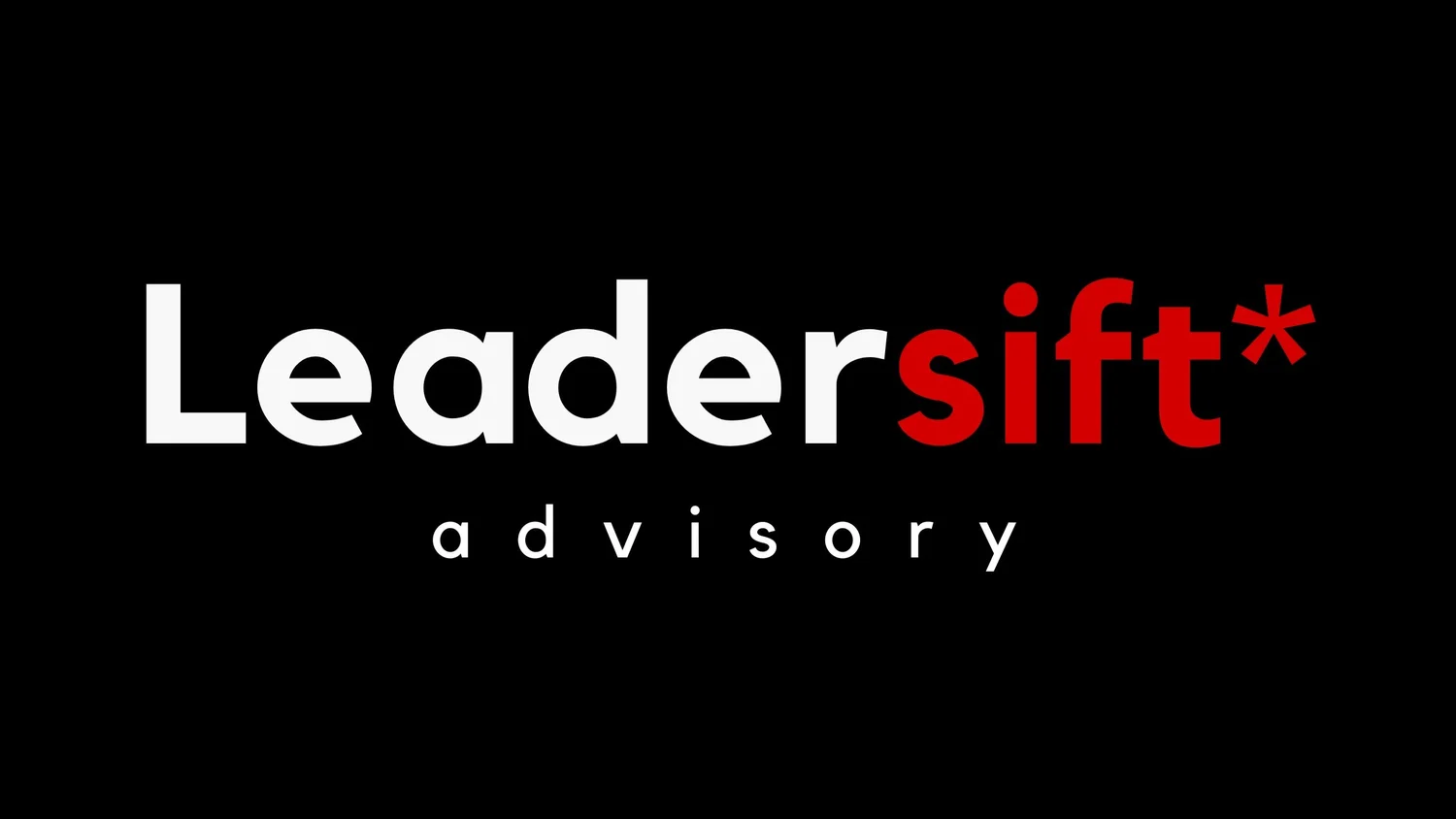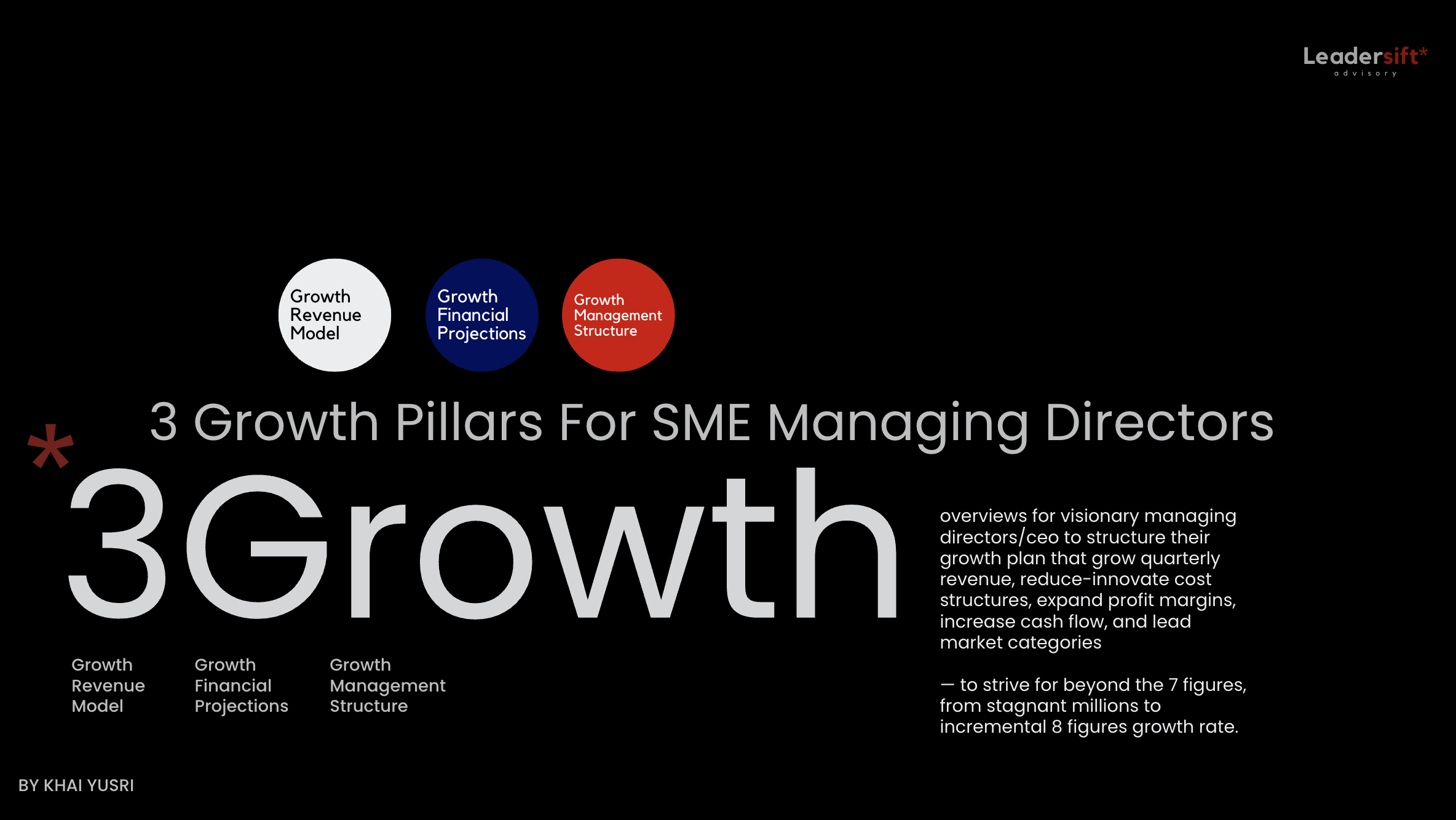We Help SMEs build Growth-Focused Management Teams and Quarterly Growth Plans
— for incremental, scalable growth rate that expand (beyond the RM5 million, RM10 million and RM20 million Annual Revenue) to lead market categories.
The Core Problem We Solve:
Most SME have ‘Growth Forecasts’ but few have the structures to achieve them...
…few SME have the structures to lead their teams for Sustainable Quarterly Growth.
After 6 years of experience helping Board Committees and Business Unit Management Teams grow their unit economics and product use cases — building organisations with growth focused teams, scalable quarterly growth plans, and sustainable positioning that stands out,
Khai Yusri founded Leadersift Advisory to now focus on helping SMEs by introducing high level business insights on Growth Management that was originally unreachable to SMEs.
About Us
An Advisory founded by a Growth Expert — For SME.
At Leadersift*, Khai helps SME to grow beyond the RM5m, RM10m, and RM20m annual revenue benchmarks with structures to Growth Management: integrating growth-focused management culture, unique differentiations that stand out, and scalable quarterly growth plans within SMEs — building teams and organisations ready to expand its infrastructures, revenue streams, and to lead market categories.
— share casual conversation over coffee/call with insights to Growth-Focused Management Teams, Sustainable Positioning, and Quarterly Scalable Growth Plans to your business’s scalable growth potentials for 2026-2028!
“Is the business actually scaling?”
— or is it stuck?
Common Signs From
The 4 Business Perspectives
(Perspective 1/4)
Operations:
”We have teams working but everything feels disconnected. There’s no clear activities that’s will contribute to sets of growth KPIs.”
“We have been growing our teams but it feels that the business is getting more complicated than it’s supposed to be. Especially when the priorities change because the financials forecasts change — we keep stacking the to-do lists without being clear on why we’re prioritising them over anything else or how those priorities will actually contribute to the best outcomes in growth. It became chaotic as everything is so messy.”
“We need a clear structure beyond the operations, a management structure that aligns everyone to the right weekly priorities that actually contribute to the month initiatives, objectives, and financial goals, not repeating boring numbers reporting and checklists without any insightful discussions.”
(Perspective 2/4)
Finance:
“We can agree with the numbers — but there’s no real building blocks on how the business is going to achieve them.”
“There’s no alignment with Sales/Marketing on how we are maximising margins for each customer segment, with Operations on quality improvements that contribute to cost optimisations, and how Finance is projecting the opportunities to maximise margins, cash flow, and expansion plans with the two functions.”
“We need better collective visibility into where we’re maximising margins cash flow, and expansion activities with Sales/Marketing, Operations, and how to link financial outcomes to what each team is actually doing.”
“Otherwise we’ll just keep growing headcount without growing margins and that’ll eat up into our cash flow and reinvestment opportunities for expansions.”
(Perspective 3/4)
Marketing/Sales:
“We’re making sales but we’re not really incrementally scaling the ratio of what we gain in sales over a quarter from each customer compared to the costs of acquiring them or their first purchase.”
“We are very much stagnant in that ratio’s growth and have to depend in acquiring lots of new customers.We are not really maximising sales for each customer and even when we do, it only happens during seasonal sales or heavy promotions/trials.”
“It’s either that we are too dependent on unprofitable customers or we are not good enough in maximising sales of the profitable customers that are coming through the pipeline through our product use cases — and we are losing the profitable customers to competitors who are good at it!”
“We need better streamlined pipelines that actually helps us stands out over market alternatives; to target, price, communicate, and sell the right things to the right customers in a scalable manner to maximise each segment’s conversions, purchasing power, and purchasing habits.”
(Perspective 4/4)
Owner/MD/CEO:
“We have an inkling of where we want this business to go and the team are working hard for that. But between all the moving parts, we can’t really feel that we’re making incremental progress.”
“Team grew and gets “busier” but there’s no incremental impact on Financial Growth from the teams. We have also reinvested in other expansions but it doesn’t seems to produce Substantial Growth Leverage with incremental margins and ROI.”
“Although our standardised operational model might be scalable with more capital, the business itself doesn’t seems to be sustainable or lean enough in achieving incremental, quarterly growth rate in margins/cash flow or to lead market categories.”
“It’s hard to get a clear overview on everything and to be able to align the teams on a roadmap for incremental growth that not just help us achieve our vision, but truly maximise our business potentials.”
“We really need a company playbook that turns our own unique strategy into structure — and structure into short term (3-24 months) and long term (24-60 months) roadmap with scalable, incremental growth rate.”
#Companies driven just by good products, marketing, and extensive capital is not enough to sustainably scale beyond the RM20 million to RM60 million mark.
Sustainable Scaling beyond RM5m, RM10m, RM20m, and above requires growth-driven management culture, unique differentiations that stand out, and scalable quarterly growth plans — to build a scalable organisation ready to expand its infrastructures, revenue streams, and lead market categories.
-> understanding this made scalable companies grow 3-5 years faster than their competitors and are able to achieve incremental 7 to 8 figures Profit & Cash growth rate.
…while other SMEs are growing their headcount but struggle to break through the RM10m or RM20m annual revenue benchmark and face shrinking margins.
Come and share a casual chat with Khai,
Principal Advisor at Leadersift*
Come share a casual chat with Khai over coffee/call and uncover board-level insights on Growth-Focused Management, Sustainable Positioning, and Scalable Quarterly Growth Plans to your business’s scalable growth potentials for 2026-2028!
P/S:
This is a casual coffee chat/call to exchange business perspectives and insights, no sales pitch nor hidden charge involved.
Chat over coffee is only available in Kuala Lumpur/Selangor, Malaysia while call through zoom or google meet is available worldwide.
This coffee chat/call is best for SME Managing Directors, Owners, Executives with annual revenue of RM2m–RM40m regardless of backgrounds, market niche, industry, or business struggles.
Feel free to bring along your partner or your preferred direct report with you!
Request Your
Coffee Chat/Call Now Here
FAQs
-
Yes, we advise Family/Generational SMEs and Founder-Led SMEs from Early-Stage (RM2m-RM10m Annual Revenue) to Medium-Stage (RM10m-RM50m Annual Revenue) regardless of industry or expertise.
However, we do look at infrastructural complexity, technicality, business dynamics, and the management itself to determine the fit of working with a specific client.
We also look at the Organisational Structure to ensure alignment between the business capabilities (talents) with its priorities and its potentials to grow with us.
p/s: ‘Determining The Fit’ of working with a client is only possible after conversations and understanding how the business work — request a casual chat with our principal advisor here!
-
We don’t do workshops that teaches business frameworks.
We do a 6-month structured advisory partnership where Leadersift works inside your management system — helping you build the decision structures, team cadence, and financial alignment required to achieve scalable growth rate that expand (beyond the RM5 million, RM10 million and RM20 million Annual Revenue) and lead market categories.
-
Growth Management Advisory: 6-Month Engagement
We advise SME Managing Directors and Teams through 3 structured phases within 6 months — not just by teaching business concepts, but by working directly with your management team to diagnose, design, and integrate Strategic Management Structures that build Growth-Focused Management Culture, Unique Differentiations That Stands Out, and Scalable Quarterly Growth Plans.
3 Phases (6 Months)
P1: Business Diagnosis (Month 1)
P2: Strategic Alignment (Month 1-2)
P3: Management Oversight (Month 2-6)
——
PHASE 1: BUSINESS DIAGNOSIS (MONTH 1)
We start with a deep-dive diagnosis to identify the key growth constraints, operational inefficiencies, and untapped potentials within your business. This involves analyzing financial performance, management structure, and market positioning to define:
What’s slowing the business down.
What strengths and differentiations can be leveraged.
What short-term (3–24 months) and long-term (24–60 months) growth opportunities exist.
PHASE 1 DELIVERABLE:
A Business Diagnostic Report outlining your current growth barriers, scalability gaps, and potential growth scenarios.——
PHASE 2: STRATEGIC ALIGNMENT (MONTH 1-2)
We collaborate across key management functions — Owner/Director, Operations, Sales, and Finance — through a series of strategic alignment sessions (not workshops) to co-structure the 4 foundational deliverables below.
Scalable Company Playbook
Translate Organisational Visions into Strategic Growth Roadmaps — quarterly and annual growth trajectories (3–60 months) with aligned management priorities on Operational Quality, Revenue Economics, Margins, Cash Flow, and Expansion Growth.
Growth-Focused Management System
Establish a clear Performance-Driven Management System through KPI Scoreboards, Team Commitments, and Meeting Rhythms.
Align every team’s weekly activities with the company’s quarterly financial and strategic objectives — focusing on Operational Quality, Revenue Economics, Margins, Cash Flow, and Expansion Growth.
Scalable Sales & Marketing Pipelines
Refine Revenue Model that guide product positioning, pricing models, customer targeting, and post-sales retention — maximising each segment’s conversions, purchasing power, and purchasing habits for incremental sales/margins quarterly growth.
Cross-Functional Financial Visibility & Control
Integrate Profitability Dashboards, Cash Flow Trackers, and Expansion Allocation Sheets that tie back to each department’s KPI and accountability system.
PHASE 2 DELIVERABLE:
A Strategic Management Blueprint — a documented, action-ready structure that links business strategy to measurable execution and financial impact.——
Phase 3: Management Oversight (Month 2–6)
Once the growth structure is in place, we work alongside your management team to embed, monitor, and refine it through advisory oversight.
Bi-Weekly Management Calls: Ensure implementation consistency, track KPI performance, and solve on-ground challenges.
Quarterly Business Review: Evaluate business performance, financial improvements, and organisational execution. Refine the next-quarter strategy to sustain growth momentum.
PHASE 3 DELIVERABLE:
A Quarterly Growth Review Pack with updated dashboards, performance metrics, and revised strategic initiatives. -
→ Price of the 6-month advisory varies depending on Annual Revenue, Business Complexity/Technicality, and Infrastructures for each business stage:
1) Small Business With Annual Revenue of RM2m-RM10m:
Advisory Fee = RM6k - RM20k
2) Early Medium Business With Annual Revenue of RM10m-RM20m:
Advisory Fee = RM30k - RM40k
3) Mid Medium Business With Annual Revenue of RM20m-RM50m:
Advisory Fee = RM40k - RM80k
#Advisory Payment Terms:
20% upfront,
80% spread monthly for 5 months.in example:
Annual Revenue = RM10 million
Full Advisory Fee = RM30,000
Upfront (20%) = RM6,000
Month 2 - Month 6 = RM4,800 monthly
-
Request A Casual Chat With Our Principal Advisor, Khai here.
-
Yes — but only with *Partners/Agencies serious about helping their clients scale beyond RM10M–RM20M.
*Partners/Agencies: Marketing, Sales, Tax, HR, Finance, Growth, M&A.
Most agencies grow by getting more clients; we want partners that amplifies their growth by helping clients scale.
Because real scalability beyond RM10-RM20m doesn’t come from just good products or good marketing — it comes from better organisational advantage, financial visibility, and management alignment.
That’s where we come in.
We work with agencies and strategic partners to:Strengthen clients’ growth economics (customers, differentiations, margins, cash flow).
Build management structures that turn strategy into scalable execution.
Help clients position to lead market categories — not just participate in them.
The result of this strategic partnership:
Stickier retainers for agencies,
Stronger client results,
Co-joint case studies that differentiate you from every other agency,
We’re open for collaborations that share one goal: helping ambitious SMEs build scalable, category-leading businesses — together.
Reserve a casual chat with our Principal Advisor now here.
-
UNIT ECONOMICS:
How long does it take for one customer to convert? (mins/hours/days/weeks/months)
How many customer do you convert?
How much do you spend to get one customer?
How much does one customer spend in new sales?
How much in ratio of customers that are extremely satisfied/dissatisfied?
How much more customers do you get from one customer?
How many customers return for purchase?
How frequent do they return? (mins/hours/days/weeks/months)
How much does each customer spend in their returning sales?
In average, how much do customer acquisition cost (CAC) compare to the total sales contribution of one customer new sales, returning sales frequencies, and additional acquired sales from referrals per day/week/month/quarter?
STRATEGIC BENCHMARKING:
Strategic Objective:
→ Increase Business Unit Sales To XX.Strategic Initiatives:
(+) Increased Channel Conversion Rate To XX.
(+) Increased Conversion Cycle To XX Mins/Hours/Days/Weeks.
(+) Increased New Customers Acquisitions To XX.
(+) Increased New Customers Sales Contribution To XX.
(+) Increased Returning Rate To XX.
(+) Increased Returning Frequency To XX Mins/Hours/Days/Weeks/Months.
(+) Increased Returning Customers Acquisitions To XX.
(+) Increased Returning Customers Sales Contribution To XX.(+) Increased Referrals To XX.
(+) Reactivated XX Churned Customers.= Revenue: XX
Growth: +n%= Gross Profit: XX
Growth: +n%—————
p/s: request to have a casual chat about this topic with our Principal Advisor here.
31 Pages Free Playbook For SME,
3 Growth Pillars For
Managing Directors.
— Structures To Scalable Growth.






